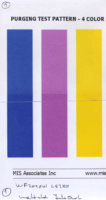- Joined
- Dec 27, 2014
- Messages
- 6,185
- Reaction score
- 7,373
- Points
- 373
- Location
- Germany
- Printer Model
- L805, WF2010, ET8550, T3100X
oh well, you know the answers to your (rhetoric??..assumingly) questions... you as a consumer are supposed to spend your money but not asking too much of such details..
Glossy papers can yield better fading performance than matte papers, but not all glossy papers are alike, just look to my posting #184 https://www.printerknowledge.com/threads/which-pigment-ink-for-epson-1500w.9323/page-19#post-92490
illustrating how much different brands of glossy papers, all of the resin coated type (RC) with a PE film layer, change the fading performance of the same ink, it is significant. So how much to do want to spend on photo papers - 10ct or 50ct or 70ct ?
I just use 4 CMYK color patches to compare - different colors fade with different speed, I can't handle the color checker 30 color patches.
You may use the freeware 'Gamutvision' to compare profiles, I'm using a pretty old version of Monaco Gamutworks I'm used to but this software is gone.
Glossy papers can yield better fading performance than matte papers, but not all glossy papers are alike, just look to my posting #184 https://www.printerknowledge.com/threads/which-pigment-ink-for-epson-1500w.9323/page-19#post-92490
illustrating how much different brands of glossy papers, all of the resin coated type (RC) with a PE film layer, change the fading performance of the same ink, it is significant. So how much to do want to spend on photo papers - 10ct or 50ct or 70ct ?
I just use 4 CMYK color patches to compare - different colors fade with different speed, I can't handle the color checker 30 color patches.
You may use the freeware 'Gamutvision' to compare profiles, I'm using a pretty old version of Monaco Gamutworks I'm used to but this software is gone.

